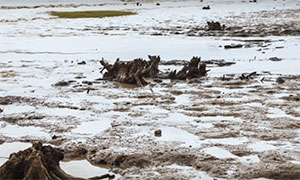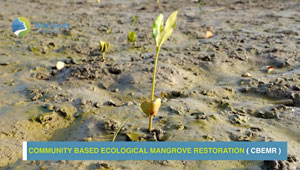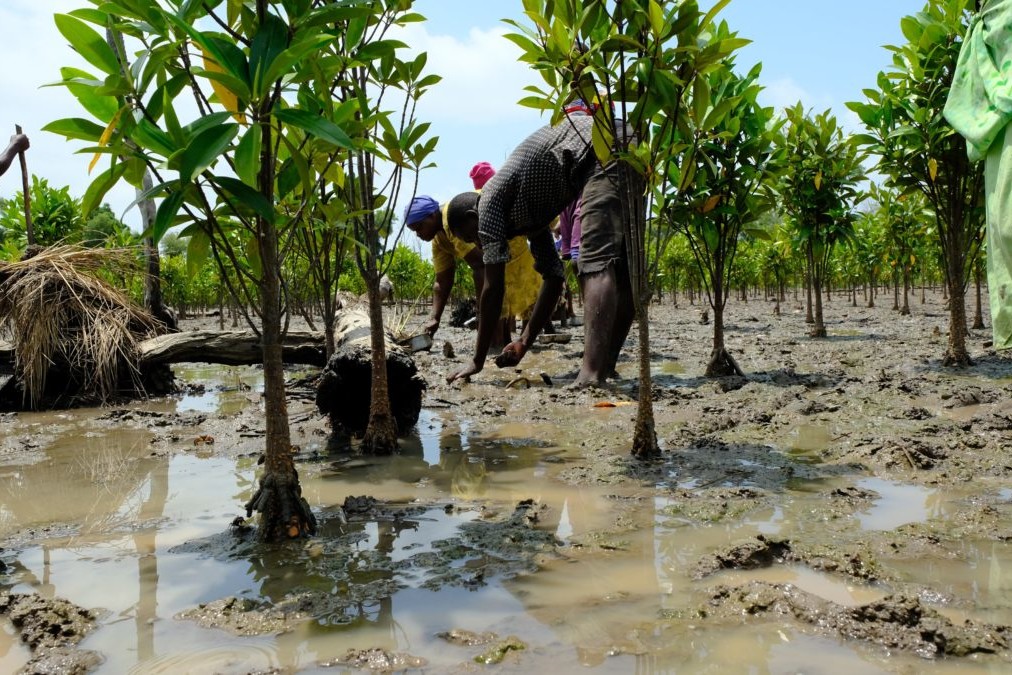The MAP News
|
|
|
Electric blue tarantula discovered in a Thai mangrove forest
 THAILAND - Researchers unearthed a new species of tarantula exhibiting a vibrant electric blue coloration, nestled within the enigmatic landscapes of Thailand’s mangrove forests. This exciting discovery unfolded in the Phang-Nga province and is the inaugural record of a tarantula species dwelling in Thai mangrove ecosystems. Dr. Narin Chomphuphuang and his research ensemble, accompanied by local wildlife aficionado and YouTuber JoCho Sippawat, embarked on this trailblazing expedition following the revelation of Taksinus bambus — the first tarantula known to inhabit bamboo stalks, in Thailand. Their quest was driven by the zeal to delve deeper into the secretive world of these arachnids. The distinctive electric blue of the tarantula immediately distinguished it from its peers, its color acting as a beacon in the dense, dark green foliage. Narin explained, “The first specimen we found was on a tree in the mangrove forest. These tarantulas inhabit hollow trees, presenting a challenge in catching them, as one needs to climb trees and lure them out of complex hollows amidst humid and slippery conditions.” The expedition meticulously maneuvered through the terrain in the evenings and nocturnal hours during low tide, overcoming obstacles to collect two specimens, showcasing the tarantula’s elusive nature. The electric blue tarantula, it was discovered, doesn’t owe its striking coloration to pigments, but rather to the intricate nanostructures within their hair, manipulating light to craft the illustrious blue hue, sometimes revealing an enchanting violet tint, creating a mesmerizing iridescent effect. THAILAND - Researchers unearthed a new species of tarantula exhibiting a vibrant electric blue coloration, nestled within the enigmatic landscapes of Thailand’s mangrove forests. This exciting discovery unfolded in the Phang-Nga province and is the inaugural record of a tarantula species dwelling in Thai mangrove ecosystems. Dr. Narin Chomphuphuang and his research ensemble, accompanied by local wildlife aficionado and YouTuber JoCho Sippawat, embarked on this trailblazing expedition following the revelation of Taksinus bambus — the first tarantula known to inhabit bamboo stalks, in Thailand. Their quest was driven by the zeal to delve deeper into the secretive world of these arachnids. The distinctive electric blue of the tarantula immediately distinguished it from its peers, its color acting as a beacon in the dense, dark green foliage. Narin explained, “The first specimen we found was on a tree in the mangrove forest. These tarantulas inhabit hollow trees, presenting a challenge in catching them, as one needs to climb trees and lure them out of complex hollows amidst humid and slippery conditions.” The expedition meticulously maneuvered through the terrain in the evenings and nocturnal hours during low tide, overcoming obstacles to collect two specimens, showcasing the tarantula’s elusive nature. The electric blue tarantula, it was discovered, doesn’t owe its striking coloration to pigments, but rather to the intricate nanostructures within their hair, manipulating light to craft the illustrious blue hue, sometimes revealing an enchanting violet tint, creating a mesmerizing iridescent effect.GLOBAL Mangroves: Our Allies Against Climate Change
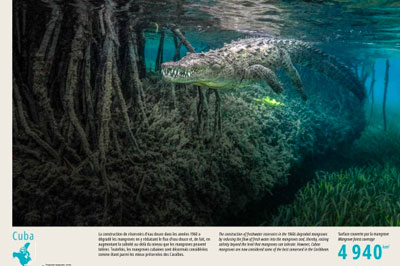 GLOBAL - Have you ever wondered why people consider mangrove forests to be our allies against climate change? Do you know whether your country has mangroves and how much land these cover? A new exhibition sets out to answer these and other questions. A series of 125 posters combine stunning photos with interesting facts and figures on the mangroves of the world. These posters will be visible on the railings that surround UNESCO headquarters in Paris until the end of September 2023. This photo exhibition takes us on a world tour, since there is a poster for every country in the world that has natural mangrove stands, as well as some of their overseas territories. Mangroves occupy the boundary between land and sea. At a time when sea levels are rising as a consequence of climate change, mangrove forests are of particular interest to scientists, since they are able to thrive in relatively saline soils. Mangroves are widespread, growing in sheltered lagoons and deltas in the tropics and subtropics in the Americas, Africa, the Middle East, Asia and the Pacific. The Sundarbans, which straddles Bangladesh and India, is the world’s largest stand-alone mangrove forest. Mangrove forests sustain local communities by providing them with seafood, wood and other products. They also mitigate the impact of climate change by sequestering carbon and protecting the coast from storm surges. GLOBAL - Have you ever wondered why people consider mangrove forests to be our allies against climate change? Do you know whether your country has mangroves and how much land these cover? A new exhibition sets out to answer these and other questions. A series of 125 posters combine stunning photos with interesting facts and figures on the mangroves of the world. These posters will be visible on the railings that surround UNESCO headquarters in Paris until the end of September 2023. This photo exhibition takes us on a world tour, since there is a poster for every country in the world that has natural mangrove stands, as well as some of their overseas territories. Mangroves occupy the boundary between land and sea. At a time when sea levels are rising as a consequence of climate change, mangrove forests are of particular interest to scientists, since they are able to thrive in relatively saline soils. Mangroves are widespread, growing in sheltered lagoons and deltas in the tropics and subtropics in the Americas, Africa, the Middle East, Asia and the Pacific. The Sundarbans, which straddles Bangladesh and India, is the world’s largest stand-alone mangrove forest. Mangrove forests sustain local communities by providing them with seafood, wood and other products. They also mitigate the impact of climate change by sequestering carbon and protecting the coast from storm surges.History happens now: A teen environmentalist provides a glimpse inside the UN General Assembly  UNITED NATIONS - “Climate collapse has begun.” With these ominous words, United Nations Secretary-General António Guterres kicked off this year’s U.N. General Assembly at the U.N. headquarters in New York City. Guterres’ opening press conference, following blistering summer heatwaves that shattered temperature records on virtually every continent on Earth, was meant to spark urgency among the world’s decision-makers. Reminding his compatriots that “climate change is here,” Guterres said: “It is terrifying. And it is just the beginning.” It is with this warning in mind that, as my own flight landed in New York, I pondered my purpose. I was set to speak with a panel of youth on our hopes for the outcome of this pivotal assembly. For those who’ve followed my journey as a teen environmentalist, you’re familiar with my optimism. And while some might label my hopefulness as naivete or downright delusion, for so long as one mangrove survives the heat in our warming city, I’ll continue in my refusal to see my world through a bleak lens and keep pursuing my lofty goal to halt climate change. Because to do anything less ensures an unthinkable ending. But to borrow the words of American journalist David Wallace-Wells, “It’s time to panic.” Guterres’ goal as the General Assembly picks up speed over the next few days is for the 193 member states to commit to take enough action to catch up on the lagging sustainable development goals that will ensure our very survival. The 17 sustainable development goals, known as the SDGs, were entered into voluntarily by all nations in 2015 and are considered essential to achieve by 2030 to ensure a sustainable future for us all. UNITED NATIONS - “Climate collapse has begun.” With these ominous words, United Nations Secretary-General António Guterres kicked off this year’s U.N. General Assembly at the U.N. headquarters in New York City. Guterres’ opening press conference, following blistering summer heatwaves that shattered temperature records on virtually every continent on Earth, was meant to spark urgency among the world’s decision-makers. Reminding his compatriots that “climate change is here,” Guterres said: “It is terrifying. And it is just the beginning.” It is with this warning in mind that, as my own flight landed in New York, I pondered my purpose. I was set to speak with a panel of youth on our hopes for the outcome of this pivotal assembly. For those who’ve followed my journey as a teen environmentalist, you’re familiar with my optimism. And while some might label my hopefulness as naivete or downright delusion, for so long as one mangrove survives the heat in our warming city, I’ll continue in my refusal to see my world through a bleak lens and keep pursuing my lofty goal to halt climate change. Because to do anything less ensures an unthinkable ending. But to borrow the words of American journalist David Wallace-Wells, “It’s time to panic.” Guterres’ goal as the General Assembly picks up speed over the next few days is for the 193 member states to commit to take enough action to catch up on the lagging sustainable development goals that will ensure our very survival. The 17 sustainable development goals, known as the SDGs, were entered into voluntarily by all nations in 2015 and are considered essential to achieve by 2030 to ensure a sustainable future for us all.AFRICA
Africa seeks united front on climate
 WESTERN AFRICA - "Africa is nature's superpower, hosting a quarter of global biodiversity. Congo Forest is one of the lungs of the earth and captures a lot of carbon. Niger Delta is one of the largest mangroves in Africa," said Muhtari Aminu-Kano, policy and government relations director for Africa region at The Nature Conservancy. Though Africa expects developed countries to honor their annual pledges for climate action in developing countries, experts are of the view that the continent should leverage its vast resource potential and technology to fight climate change as the crisis continues to worsen. At the end of the three-day Africa Climate Summit in the Kenyan capital Nairobi, African leaders issued the Nairobi Declaration, which urged developed nations to honor their commitments to provide $100 billion in annual climate finance for the continent. The declaration also calls for a new financing architecture that is responsive to Africa's needs, including debt restructuring and relief. In addition to developing a new Global Climate Finance Charter through the United Nations General Assembly and Conference of the Parties to the UN Framework Convention on Climate Change by 2025, leaders at the summit also resolved to promote sustainable utilization of Africa's natural assets for the continent's progression toward low-carbon development. According to the UN, Africa holds 25 percent of the world's biodiversity, 10 percent of internal renewable fresh water, the largest reserves of cobalt, diamonds, platinum and uranium, and has the second-largest carbon sink. WESTERN AFRICA - "Africa is nature's superpower, hosting a quarter of global biodiversity. Congo Forest is one of the lungs of the earth and captures a lot of carbon. Niger Delta is one of the largest mangroves in Africa," said Muhtari Aminu-Kano, policy and government relations director for Africa region at The Nature Conservancy. Though Africa expects developed countries to honor their annual pledges for climate action in developing countries, experts are of the view that the continent should leverage its vast resource potential and technology to fight climate change as the crisis continues to worsen. At the end of the three-day Africa Climate Summit in the Kenyan capital Nairobi, African leaders issued the Nairobi Declaration, which urged developed nations to honor their commitments to provide $100 billion in annual climate finance for the continent. The declaration also calls for a new financing architecture that is responsive to Africa's needs, including debt restructuring and relief. In addition to developing a new Global Climate Finance Charter through the United Nations General Assembly and Conference of the Parties to the UN Framework Convention on Climate Change by 2025, leaders at the summit also resolved to promote sustainable utilization of Africa's natural assets for the continent's progression toward low-carbon development. According to the UN, Africa holds 25 percent of the world's biodiversity, 10 percent of internal renewable fresh water, the largest reserves of cobalt, diamonds, platinum and uranium, and has the second-largest carbon sink.The Great Blue Wall to rescue Africa’s sea life
 KENYA - Rising sea levels, high ocean temperatures, cyclones, floods, and increased seawater salination have caused the continent loss of lives and livelihoods, hunger, malnutrition, loss of property, and human displacement every year, especially hitting the continent’s coastal communities. In recognising the urgent need for action to counter these effects of climate change, the Great Blue Wall (GBW), an initiative that has been at the forefront of fostering Africa’s blue economy, climate adaptation and resilience, was born at COP 26 in 2021 in Glasgow, Scotland. Western Indian Ocean (WIO) states comprise the Eastern African coastal nations of Somalia, Kenya, Tanzania, Mozambique, South Africa, as well as the island states of Comoros, Madagascar, Mauritius, Seychelles and the overseas French territories of Mayotte and Reunion. These nations, in partnership with the International Union for Conservation of Nature (IUCN) launched the GBW as a network of marine and coastal conserved areas to benefit biodiversity and local livelihoods and empower communities to become stewards of the ocean. It is a movement that was basically launched to conserve and restore marine and coastal biodiversity while harnessing the development of a regenerative sustainable blue economy. This supports an abundance of marine life including important fish species, sharks and rays, turtles, sea birds, and marine mammals. KENYA - Rising sea levels, high ocean temperatures, cyclones, floods, and increased seawater salination have caused the continent loss of lives and livelihoods, hunger, malnutrition, loss of property, and human displacement every year, especially hitting the continent’s coastal communities. In recognising the urgent need for action to counter these effects of climate change, the Great Blue Wall (GBW), an initiative that has been at the forefront of fostering Africa’s blue economy, climate adaptation and resilience, was born at COP 26 in 2021 in Glasgow, Scotland. Western Indian Ocean (WIO) states comprise the Eastern African coastal nations of Somalia, Kenya, Tanzania, Mozambique, South Africa, as well as the island states of Comoros, Madagascar, Mauritius, Seychelles and the overseas French territories of Mayotte and Reunion. These nations, in partnership with the International Union for Conservation of Nature (IUCN) launched the GBW as a network of marine and coastal conserved areas to benefit biodiversity and local livelihoods and empower communities to become stewards of the ocean. It is a movement that was basically launched to conserve and restore marine and coastal biodiversity while harnessing the development of a regenerative sustainable blue economy. This supports an abundance of marine life including important fish species, sharks and rays, turtles, sea birds, and marine mammals.AMERICAS
Indigenous-Led Education Network named winner of the Inclusive Global Environmental Facility Challenge to save the Rainforest  CANADA - At the Seventh Assembly of the Global Environmental Facility (GEF) in Vancouver, British Columbia, the Indigenous-Led Education Network (ILED), a dynamic collaborative network of indigenous-led education initiatives from across several nations, was one of 23 proud winners of the GEF Inclusive Challenge Program. This acknowledgment continues a wave of international recognition of the valuable role of indigenous communities in looking after our planet’s most vital ecosystems and the importance of support for innovative, grassroots approaches to a more sustainable future. The Challenge seeks to support and elevate community-driven climate and nature projects and the unique contributions of indigenous peoples, women, girls, and young people to pressing global environmental challenges. The establishment of the UN Inclusive GEF Challenge fund and the recognition of ILED's accomplishments is an acknowledgment of the pivotal role that indigenous youth and their knowledge play in safeguarding tropical rainforests and combating climate change. ILED, supported by the Rutu Foundation, is a network of grassroots, indigenous-led organizations across Africa, Latin America and Asia aimed at passing on their environmental wisdom to the next generations. CANADA - At the Seventh Assembly of the Global Environmental Facility (GEF) in Vancouver, British Columbia, the Indigenous-Led Education Network (ILED), a dynamic collaborative network of indigenous-led education initiatives from across several nations, was one of 23 proud winners of the GEF Inclusive Challenge Program. This acknowledgment continues a wave of international recognition of the valuable role of indigenous communities in looking after our planet’s most vital ecosystems and the importance of support for innovative, grassroots approaches to a more sustainable future. The Challenge seeks to support and elevate community-driven climate and nature projects and the unique contributions of indigenous peoples, women, girls, and young people to pressing global environmental challenges. The establishment of the UN Inclusive GEF Challenge fund and the recognition of ILED's accomplishments is an acknowledgment of the pivotal role that indigenous youth and their knowledge play in safeguarding tropical rainforests and combating climate change. ILED, supported by the Rutu Foundation, is a network of grassroots, indigenous-led organizations across Africa, Latin America and Asia aimed at passing on their environmental wisdom to the next generations.ASIA Mannar, Chilaw shrimp farms face scrutiny over effluents
 SRI LANKA - After a recent field study found that a majority of shrimp and aquaculture farms across the country have failed to comply with environmental regulations, the Fisheries Ministry directed relevant government agencies, the National Aquatic Culture Development Authority (NAQDA) and the National Aquatic Resources Development and Research Agency (NARA) to take immediate legal action against those farms. “Take legal action against all the shrimp farms in Mannar and Chilaw areas that don’t release wastewater in a proper way,” Fisheries Minister Douglas Devananda directed senior officials at a meeting held last Friday to discuss issues regarding the mismanagement of shrimp farms in the North and North-Western provinces. While stressing the need to take legal action against those companies “irrespective of their status”, Mr. Devananda also directed officials to submit a report on action taken and take action against the NAQDA officials who did not fulfil their responsibility, according to a statement issued by the ministry on the meeting. A separate report has also been called on the measures taken against NAQDA officials who failed in their duties to ensure that shrimp farms adhered to environmental regulations. A recent field study carried out by relevant agencies found that of the 670 shrimp farms in the Chilaw and Puttalam areas, at least 273 lacked proper wastewater management plans. Mr. Devananda visited some of those farms recently and observed that it’s the responsibility of NAQDA and NARA to regularly monitor the farms’ wastewater management systems. SRI LANKA - After a recent field study found that a majority of shrimp and aquaculture farms across the country have failed to comply with environmental regulations, the Fisheries Ministry directed relevant government agencies, the National Aquatic Culture Development Authority (NAQDA) and the National Aquatic Resources Development and Research Agency (NARA) to take immediate legal action against those farms. “Take legal action against all the shrimp farms in Mannar and Chilaw areas that don’t release wastewater in a proper way,” Fisheries Minister Douglas Devananda directed senior officials at a meeting held last Friday to discuss issues regarding the mismanagement of shrimp farms in the North and North-Western provinces. While stressing the need to take legal action against those companies “irrespective of their status”, Mr. Devananda also directed officials to submit a report on action taken and take action against the NAQDA officials who did not fulfil their responsibility, according to a statement issued by the ministry on the meeting. A separate report has also been called on the measures taken against NAQDA officials who failed in their duties to ensure that shrimp farms adhered to environmental regulations. A recent field study carried out by relevant agencies found that of the 670 shrimp farms in the Chilaw and Puttalam areas, at least 273 lacked proper wastewater management plans. Mr. Devananda visited some of those farms recently and observed that it’s the responsibility of NAQDA and NARA to regularly monitor the farms’ wastewater management systems.Singapore’s first large-scale mangrove restoration project moves ahead
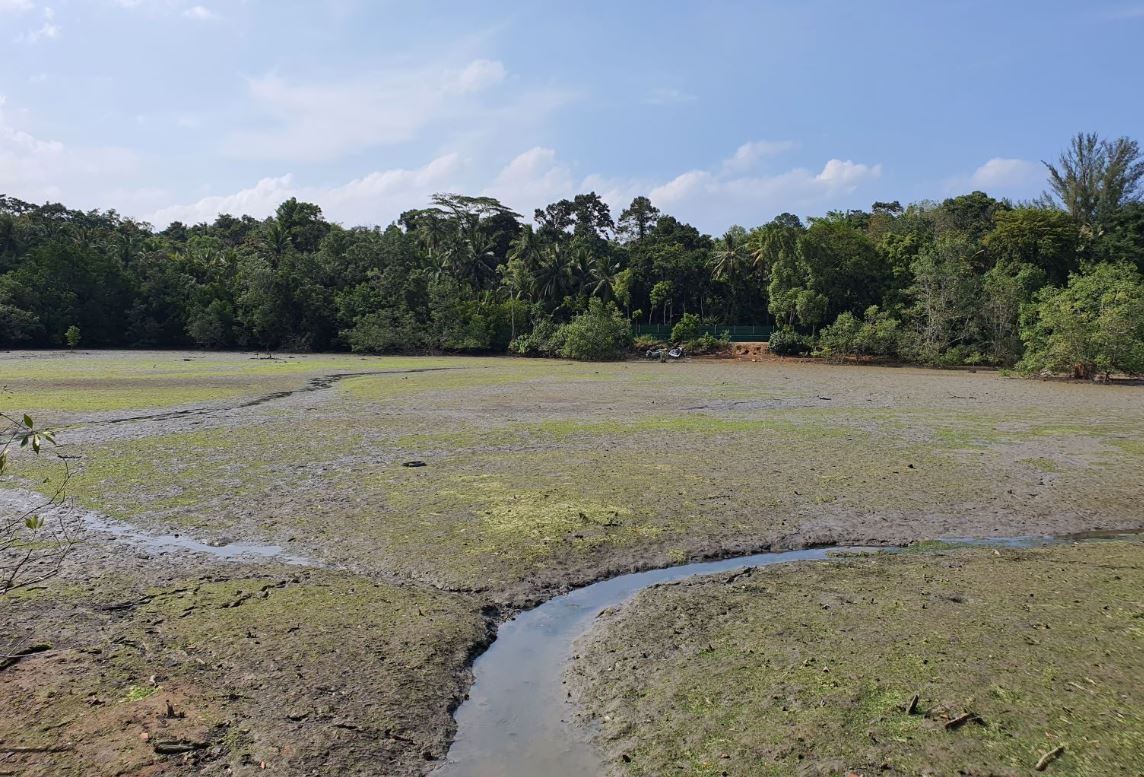 SINGAPORE - “Last year, we announced the establishment of the OCBC Mangrove Park at Sungei Durian ponds along the southern coast of Pulau Ubin, the first large-scale Ecological Mangrove Restoration project in Singapore,” said Nparks. Site preparation will commence in 2024, which include earth-filling to raise the elevation of the pond beds, improving hydrology, and maximising sediment retention. With this, an estimated 8,000 mangrove plants are expected to naturally establish at the site. “Ahead of this, we engaged academics, the nature community and Friends of Ubin Network (FUN) to discuss the design concept and findings of the Environmental Impact Assessment (EIA) which studied the potential impacts of the proposed works on the environment,” NParks said. The study concluded that the proposed works would not cause significant environmental impacts with the use of silt curtains and silt fences as mitigation measures. SINGAPORE - “Last year, we announced the establishment of the OCBC Mangrove Park at Sungei Durian ponds along the southern coast of Pulau Ubin, the first large-scale Ecological Mangrove Restoration project in Singapore,” said Nparks. Site preparation will commence in 2024, which include earth-filling to raise the elevation of the pond beds, improving hydrology, and maximising sediment retention. With this, an estimated 8,000 mangrove plants are expected to naturally establish at the site. “Ahead of this, we engaged academics, the nature community and Friends of Ubin Network (FUN) to discuss the design concept and findings of the Environmental Impact Assessment (EIA) which studied the potential impacts of the proposed works on the environment,” NParks said. The study concluded that the proposed works would not cause significant environmental impacts with the use of silt curtains and silt fences as mitigation measures.Fishermen's woes: 350 families deprived of food aid for 8 year
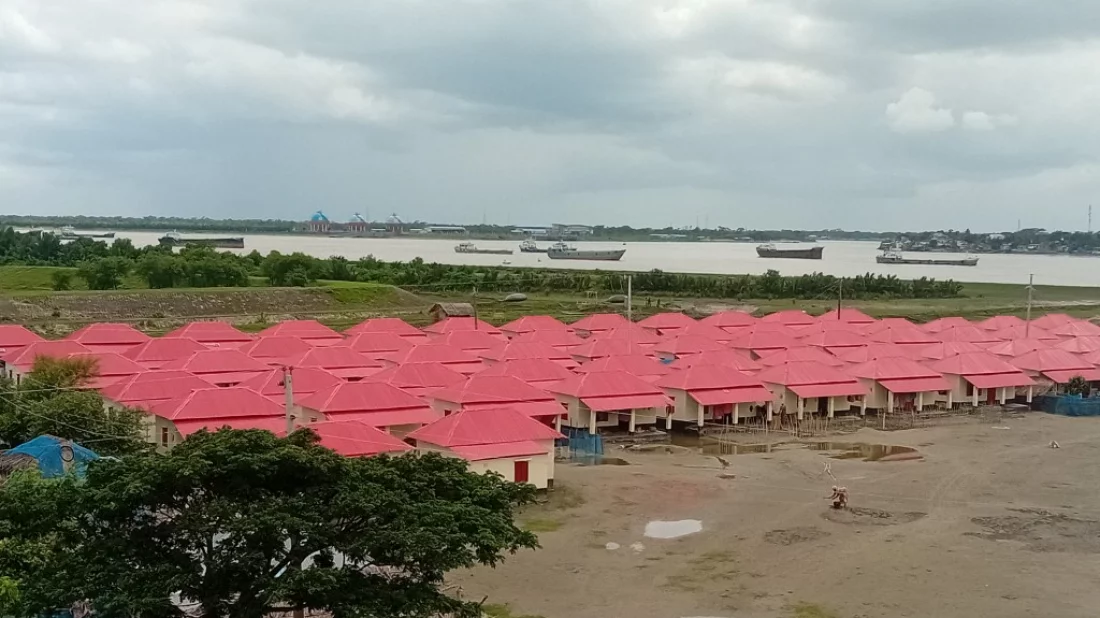 INDIA - Ershad Ali Ghazi, a fisherman in Kaibaddasakathi Char in Bagerhat’s Rampal, was registered under the Fisheries Department for food aid eight years ago when he was given a card. Using such cards, the enlisted fishermen are supposed to collect 30 kgs of rice twice a year when the government enforces a ban on fishing in the sea, rivers and the Sundarbans to ensure a safe breeding ground for fish. Ershad Ali says fishing is his sole source of income. Therefore, earning money to buy daily necessities and bear other expenses for his family of five members often seems impossible during the ban as he has to work as a farmer or as a daily wage-earner. During a recent visit to the area, the Dhaka Tribune correspondent discovered that Ershad is among around 350 fishermen living in the char areas of Gourambha Union who have never received any government food assistance in the last 8-11 years. Despite that, Ershad was preparing for the new season as the 65-day ban on fishing in the sea was lifted on July 23. The livelihood of the fishermen is hampered when the government enforces a three-month ban on entry into the Sundarbans mangrove forest from June 1-August 31. Moreover, these fishermen depend on sea resources during the ban on fishing in the rivers in the ilish season in March-April and three weeks in October. INDIA - Ershad Ali Ghazi, a fisherman in Kaibaddasakathi Char in Bagerhat’s Rampal, was registered under the Fisheries Department for food aid eight years ago when he was given a card. Using such cards, the enlisted fishermen are supposed to collect 30 kgs of rice twice a year when the government enforces a ban on fishing in the sea, rivers and the Sundarbans to ensure a safe breeding ground for fish. Ershad Ali says fishing is his sole source of income. Therefore, earning money to buy daily necessities and bear other expenses for his family of five members often seems impossible during the ban as he has to work as a farmer or as a daily wage-earner. During a recent visit to the area, the Dhaka Tribune correspondent discovered that Ershad is among around 350 fishermen living in the char areas of Gourambha Union who have never received any government food assistance in the last 8-11 years. Despite that, Ershad was preparing for the new season as the 65-day ban on fishing in the sea was lifted on July 23. The livelihood of the fishermen is hampered when the government enforces a three-month ban on entry into the Sundarbans mangrove forest from June 1-August 31. Moreover, these fishermen depend on sea resources during the ban on fishing in the rivers in the ilish season in March-April and three weeks in October.Like this newsletter?  Pease consider donating to MAP to keep it going. Giving could never be easier *Articles in this newsletter may mention practices being used and/or show exagerated results being claimed without proof. Stories are presented here in effort to show mangrove related activity around the world and do not necessarily reflect Mangrove Action Project's views or mangrove restoration best-practices. ACTION ALERTSEcuador: Stop land grabbing and racial discrimination for palm oil! SIGN THE PETITIONUGANDA Stop criminalizing pipeline protesters! SIGN THE PETITIONSave Endangered Species From SpaceX
|
|
|
Mangrove Action Project Click here to view past newsletters
|
|
Search News Archive
Saturday, September 23, 2023
MAP News Issue #581 - Sept 23, 2023
Saturday, September 9, 2023
MAP News Issue #580 - Sept. 09, 2023
PREVIEW VERSION
The MAP News
|
|
|
Bees helping replenish the mangrove population in Tampa Bay
 USA - Josh Harris is a commercial fisherman with a deep love for Tampa Bay. "From the time I was two years old is my earliest memories of fishing off my grandfather’s dock," he recalled. But it's his other business venture that has this conservationist buzzing with excitement. Harris owns Queen and Colony Bee Company and manages 200 colonies around Tampa Bay. Harris has noticed something special at his hives close to the water. His bees are producing mangrove honey. "It’s a rare honey in Florida because we don’t have the concentration of mangroves we used to," he explained. Since the 1900s, Tampa Bay has lost about half of its mangrove trees due to development, climate change, and water pollution. And that's not good for the health of the bay. "They are along the coastline; they stabilize the shoreline. They prevent erosion, and they also filter nutrients and pollutants from the water. So, they clean the water," shared Harris. Harris said the hard work of his bees is directly helping the mangrove population around Tampa Bay. "As the bees go around and pollinate the flowers, they allow those trees to go to seed. The seeds will fall into the bay and get spread around by the tides and the wind and have the opportunity to produce new mangrove trees that will continue that process of cleaning the water," explained Harris. As he sees new mangrove growth around his hives, it gives him hope for the future of Tampa Bay. "As a commercial fisherman, I rely on the fish in Tampa Bay and the crabs to provide for my family. We want to see our livelihood continue. We want to see our children have the opportunity to continue the tradition," shared Harris. USA - Josh Harris is a commercial fisherman with a deep love for Tampa Bay. "From the time I was two years old is my earliest memories of fishing off my grandfather’s dock," he recalled. But it's his other business venture that has this conservationist buzzing with excitement. Harris owns Queen and Colony Bee Company and manages 200 colonies around Tampa Bay. Harris has noticed something special at his hives close to the water. His bees are producing mangrove honey. "It’s a rare honey in Florida because we don’t have the concentration of mangroves we used to," he explained. Since the 1900s, Tampa Bay has lost about half of its mangrove trees due to development, climate change, and water pollution. And that's not good for the health of the bay. "They are along the coastline; they stabilize the shoreline. They prevent erosion, and they also filter nutrients and pollutants from the water. So, they clean the water," shared Harris. Harris said the hard work of his bees is directly helping the mangrove population around Tampa Bay. "As the bees go around and pollinate the flowers, they allow those trees to go to seed. The seeds will fall into the bay and get spread around by the tides and the wind and have the opportunity to produce new mangrove trees that will continue that process of cleaning the water," explained Harris. As he sees new mangrove growth around his hives, it gives him hope for the future of Tampa Bay. "As a commercial fisherman, I rely on the fish in Tampa Bay and the crabs to provide for my family. We want to see our livelihood continue. We want to see our children have the opportunity to continue the tradition," shared Harris.GLOBAL Will the world's mangroves, marshes and coral survive warm, rising seas?
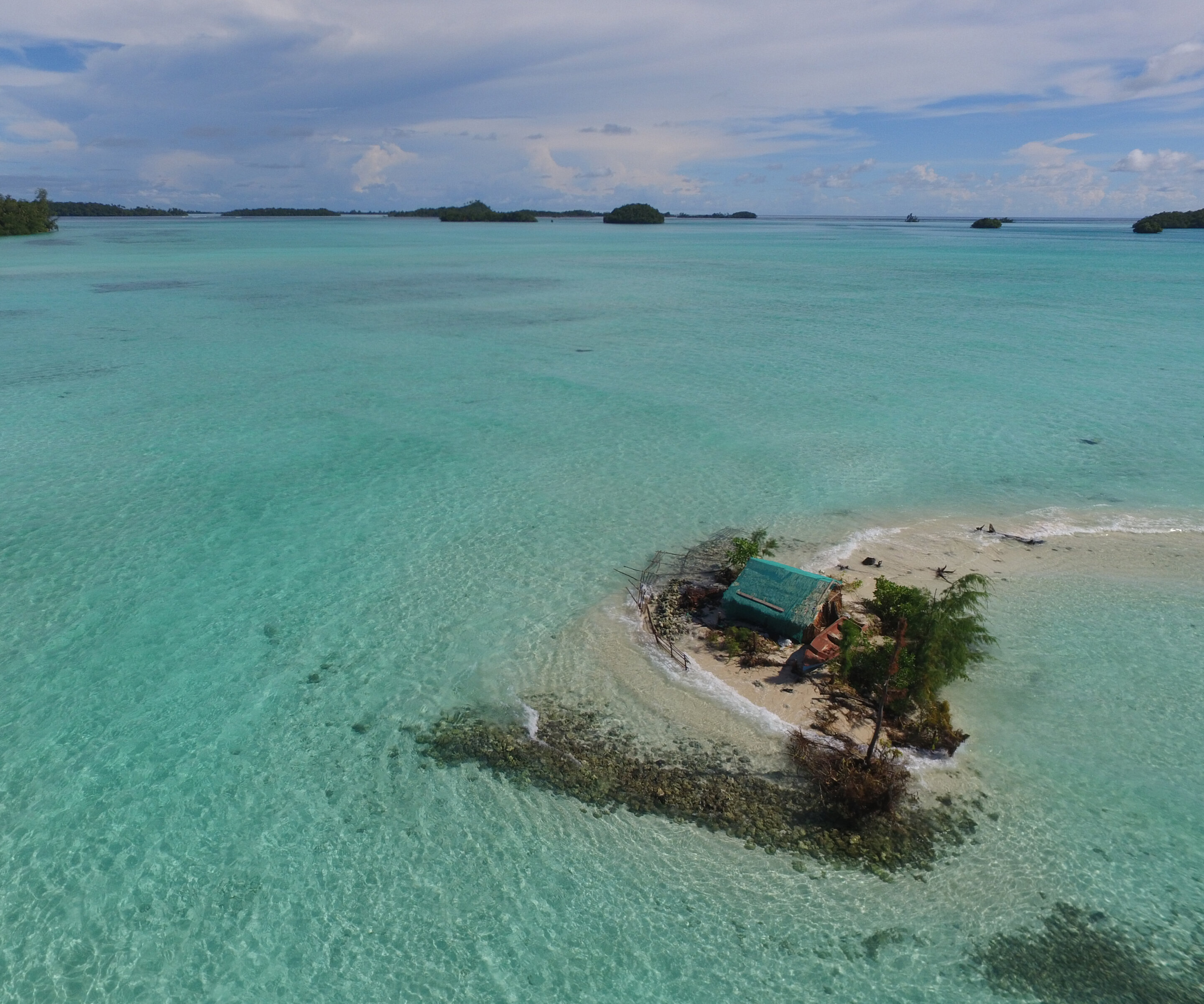 AUSTRALIA - Research published in Nature warns that rising seas will devastate coastal habitats, using evidence from the last Ice Age. 17,000 years ago you could walk from Germany to England, from Russia to America, from mainland Australia to Tasmania. Sea levels were about 120 meters lower than today. But, as the last Ice Age ended, the oceans rose quickly by one meter a century on average. Vast swathes of coastal habitat were wiped out. Recovery took thousands of years. Rapid sea level rise and coastal habitat retreat will happen again if warming levels rise above Paris Agreement targets, warns a global research team led by Macquarie University. They say that these mangroves, marshes, coral reefs and coral islands are essential to protect coastlines, trap carbon, nurture juvenile fish and help sustain millions of coastal residents. In the paper the authors, from 17 institutions in Australia, Singapore, Germany, U.S., Hong Kong and the UK, report on how these coastal habitats retreated and adapted as the last Ice Age ended and how they are likely to cope with this century's predicted sea level rises. "Coastal ecosystems exist where our oceans meet the land, including mangroves, coastal marshes and the fringes of sandy coral islands—the low-lying areas flooded and drained by tidal salt water," said lead author, coastal wetlands specialist Professor Neil Saintilan from Sydney's Macquarie University. Sea-level rise impacts, Solomon Islands. Credit: Simon Albert, University of Queensland "Our research shows these coastal habitats can likely adapt to some degree of rising sea levels but will reach a tipping point beyond sea-level rises triggered by more than 1.5 to 2°C of global warming. AUSTRALIA - Research published in Nature warns that rising seas will devastate coastal habitats, using evidence from the last Ice Age. 17,000 years ago you could walk from Germany to England, from Russia to America, from mainland Australia to Tasmania. Sea levels were about 120 meters lower than today. But, as the last Ice Age ended, the oceans rose quickly by one meter a century on average. Vast swathes of coastal habitat were wiped out. Recovery took thousands of years. Rapid sea level rise and coastal habitat retreat will happen again if warming levels rise above Paris Agreement targets, warns a global research team led by Macquarie University. They say that these mangroves, marshes, coral reefs and coral islands are essential to protect coastlines, trap carbon, nurture juvenile fish and help sustain millions of coastal residents. In the paper the authors, from 17 institutions in Australia, Singapore, Germany, U.S., Hong Kong and the UK, report on how these coastal habitats retreated and adapted as the last Ice Age ended and how they are likely to cope with this century's predicted sea level rises. "Coastal ecosystems exist where our oceans meet the land, including mangroves, coastal marshes and the fringes of sandy coral islands—the low-lying areas flooded and drained by tidal salt water," said lead author, coastal wetlands specialist Professor Neil Saintilan from Sydney's Macquarie University. Sea-level rise impacts, Solomon Islands. Credit: Simon Albert, University of Queensland "Our research shows these coastal habitats can likely adapt to some degree of rising sea levels but will reach a tipping point beyond sea-level rises triggered by more than 1.5 to 2°C of global warming.Carbon Neutral Is Dead; Long Live Nature Positive  GLOBAL - Since the term ‘carbon neutral’ was first introduced, thousands of companies have issued reports and strategies outlining the myriad ways they plan to offset their carbon emissions in a few years — with tree planting being the marketing-friendly offset of choice. However, paying to pollute — as some see it — has never been without controversy. And recently, many have questioned if any of those trees were planted, anyway. The ‘carbon-neutral industry,’ based upon buying offset credits equal to your emissions, is in a crisis faintly reminiscent of the climate crisis it’s supposed to help solve. When the carbon-neutral craze started, it felt bold and groundbreaking. In 1988, Allied Energy Services and the World Resources Institute introduced the first-ever project to offset emissions from a coal-fired power plant. In 1997, more than 150 countries had signed the UN’s Kyoto Protocol — an international treaty that aimed to limit or reduce greenhouse gas (GHG) emissions. Emissions trading was one of the three core mechanisms of the treaty — carbon became an internationally recognized commodity; and the carbon market was born. In the early 00’s, major companies including Sky Media and Google became some of the first to offset their emissions or go carbon neutral — setting off a domino effect of companies announcing ambitious targets and goals. But, in the years since then, we’ve learned that that’s not how carbon really works. With our legacy, ‘permission to pollute’ is no longer viable. Like other areas of sustainability, over the years many honest and well-intentioned attempts to redistribute emissions have become excellent fodder for corporations to greenwash their efforts. GLOBAL - Since the term ‘carbon neutral’ was first introduced, thousands of companies have issued reports and strategies outlining the myriad ways they plan to offset their carbon emissions in a few years — with tree planting being the marketing-friendly offset of choice. However, paying to pollute — as some see it — has never been without controversy. And recently, many have questioned if any of those trees were planted, anyway. The ‘carbon-neutral industry,’ based upon buying offset credits equal to your emissions, is in a crisis faintly reminiscent of the climate crisis it’s supposed to help solve. When the carbon-neutral craze started, it felt bold and groundbreaking. In 1988, Allied Energy Services and the World Resources Institute introduced the first-ever project to offset emissions from a coal-fired power plant. In 1997, more than 150 countries had signed the UN’s Kyoto Protocol — an international treaty that aimed to limit or reduce greenhouse gas (GHG) emissions. Emissions trading was one of the three core mechanisms of the treaty — carbon became an internationally recognized commodity; and the carbon market was born. In the early 00’s, major companies including Sky Media and Google became some of the first to offset their emissions or go carbon neutral — setting off a domino effect of companies announcing ambitious targets and goals. But, in the years since then, we’ve learned that that’s not how carbon really works. With our legacy, ‘permission to pollute’ is no longer viable. Like other areas of sustainability, over the years many honest and well-intentioned attempts to redistribute emissions have become excellent fodder for corporations to greenwash their efforts.AFRICA How a salt-loving tree is helping to protect Mozambique from climate change
 MOZAMBIQUE - The rhythmic sound of voices singing in harmony floats across Mozambique’s Limpopo River as several women stand ankle deep in the sticky mud along its banks. In a well-rehearsed routine, one woman scoops up sediment with a hoe while another buries a fragile mangrove sapling in the void. The joyous songs of the women obscure the difficulty of their job. “It’s hard work, because we work in the mud,” said Josefina Augusto Boca, 42. “But we don’t mind it because we know its importance. We know it’s for the benefit of our community.” Boca is one of 22 women involved in an effort to replant mangrove trees in the Mahielene-Xai Xai district, which is some 200km north of Mozambique’s capital, Maputo. The project, which is led by the United Nations Environment Programme (UNEP) and funded by the Global Environment Facility, is aiming to revive the district’s once-thriving mangrove forests, many of which have fallen victim to logging and cyclones. “Projects such as this one, which focus on reviving natural infrastructure, are critical to protecting both people and nature as we enter an uncertain climate future.” The project’s backers are hoping the mangroves – which thrive in the salty waters of coastlines and estuaries – will create a buffer around local communities, shielding them from storm surges and other extreme weather linked to the climate crisis. “As cyclones in the Indian Ocean get stronger, they will cause ever greater destruction and loss of life unless we invest in nature-based solutions, like mangroves, to shore up coastlines,” said Leticia Carvalho, Head of Marine and Freshwater at UNEP. “Projects such as this one, which focus on reviving natural infrastructure, are critical to protecting both people and nature as we enter an uncertain climate future.” MOZAMBIQUE - The rhythmic sound of voices singing in harmony floats across Mozambique’s Limpopo River as several women stand ankle deep in the sticky mud along its banks. In a well-rehearsed routine, one woman scoops up sediment with a hoe while another buries a fragile mangrove sapling in the void. The joyous songs of the women obscure the difficulty of their job. “It’s hard work, because we work in the mud,” said Josefina Augusto Boca, 42. “But we don’t mind it because we know its importance. We know it’s for the benefit of our community.” Boca is one of 22 women involved in an effort to replant mangrove trees in the Mahielene-Xai Xai district, which is some 200km north of Mozambique’s capital, Maputo. The project, which is led by the United Nations Environment Programme (UNEP) and funded by the Global Environment Facility, is aiming to revive the district’s once-thriving mangrove forests, many of which have fallen victim to logging and cyclones. “Projects such as this one, which focus on reviving natural infrastructure, are critical to protecting both people and nature as we enter an uncertain climate future.” The project’s backers are hoping the mangroves – which thrive in the salty waters of coastlines and estuaries – will create a buffer around local communities, shielding them from storm surges and other extreme weather linked to the climate crisis. “As cyclones in the Indian Ocean get stronger, they will cause ever greater destruction and loss of life unless we invest in nature-based solutions, like mangroves, to shore up coastlines,” said Leticia Carvalho, Head of Marine and Freshwater at UNEP. “Projects such as this one, which focus on reviving natural infrastructure, are critical to protecting both people and nature as we enter an uncertain climate future.” AMERICAS
International Coastal Cleanup Miami-Dade County - Saturday, Sept 16, 2023 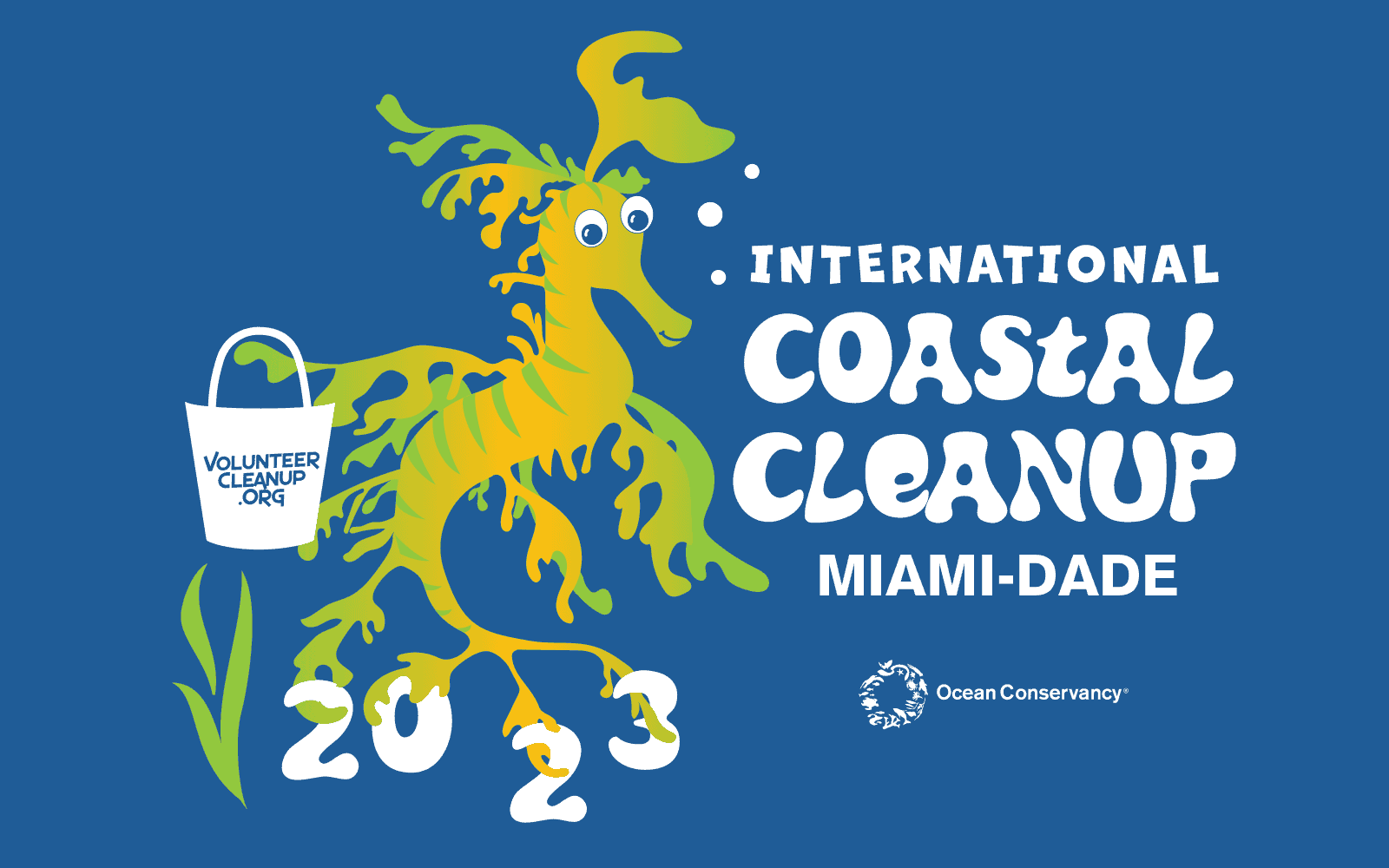 USA - Spearheaded globally by the Ocean Conservancy, VolunteerCleanup.org organizes Miami-Dade County’s local participation in this worldwide event with 50+ shoreline cleanups around the county. The 2023 Miami-Dade ICC is made possible by the generous support of our presenting sponsors Covanta and Boucher Brothers, with additional support from Blackstone Charitable Foundation, The Brady Hunter Foundation, Benjamin & Gloria Joannou, Jr. Family Conservation Fund, City of Miami Beach, The Miami Foundation, Loud And Live, and Miami-Dade County RER-DERM The Brady Hunter Foundation has generously purchased 2,000 Biscayne Bay specialty license plates and is giving them away to our volunteers. Let’s get these beauties onto your cars! It’s is first come, first serve, so please don’t be shy. In partnership with volunteer organizations and individuals around the globe, the International Coastal Cleanup® (ICC) engages people to remove trash from the world’s beaches and waterways. Thanks to millions of volunteers around the world, the ICC has become a beacon of hope, leading and inspiring action in support of our ocean. Since its beginning, more than 17 million volunteers have collected more than 350 million pounds of trash. USA - Spearheaded globally by the Ocean Conservancy, VolunteerCleanup.org organizes Miami-Dade County’s local participation in this worldwide event with 50+ shoreline cleanups around the county. The 2023 Miami-Dade ICC is made possible by the generous support of our presenting sponsors Covanta and Boucher Brothers, with additional support from Blackstone Charitable Foundation, The Brady Hunter Foundation, Benjamin & Gloria Joannou, Jr. Family Conservation Fund, City of Miami Beach, The Miami Foundation, Loud And Live, and Miami-Dade County RER-DERM The Brady Hunter Foundation has generously purchased 2,000 Biscayne Bay specialty license plates and is giving them away to our volunteers. Let’s get these beauties onto your cars! It’s is first come, first serve, so please don’t be shy. In partnership with volunteer organizations and individuals around the globe, the International Coastal Cleanup® (ICC) engages people to remove trash from the world’s beaches and waterways. Thanks to millions of volunteers around the world, the ICC has become a beacon of hope, leading and inspiring action in support of our ocean. Since its beginning, more than 17 million volunteers have collected more than 350 million pounds of trash.FGCU researchers, students document mangrove losses due to Hurricane Ian  USA - Win Everham hops off the starboard side of a 17-foot Carolina Skiff and into the waist-deep waters near Florida Gulf Coast University’s marine laboratory in Bonita Springs. Wearing a key lime pie‑colored shirt and FGCU hat, Everham pulls the boat toward a mangrove island and hands the bowline to fellow marine professor Brian Bovard. He wraps a hip pack around his neck and left shoulder as he grabs a red mangrove limb and pulls himself up and onto the mucky island. “There are places where one storm has hit and there are places where five storms have hit,” Everham says, describing the university's hurricane data. “The space between hurricanes is compressing and it may be that the ability of the forest to recover is being overwhelmed." Everham, Bovard and dozens of FGCU students and researchers have studied this island for years, and they've been waiting for a big storm to come along and smash into this section of mangrove shoreline. "Mortalities above 30% are rare and above 50% just doesn’t happen," he says while trapsing through the jungle-like forest. "The trees that are there are the ones that can survive hurricanes and the idea that a mangrove could have mortalities this high was surprising to me. It could be what’s happening is no longer natural." USA - Win Everham hops off the starboard side of a 17-foot Carolina Skiff and into the waist-deep waters near Florida Gulf Coast University’s marine laboratory in Bonita Springs. Wearing a key lime pie‑colored shirt and FGCU hat, Everham pulls the boat toward a mangrove island and hands the bowline to fellow marine professor Brian Bovard. He wraps a hip pack around his neck and left shoulder as he grabs a red mangrove limb and pulls himself up and onto the mucky island. “There are places where one storm has hit and there are places where five storms have hit,” Everham says, describing the university's hurricane data. “The space between hurricanes is compressing and it may be that the ability of the forest to recover is being overwhelmed." Everham, Bovard and dozens of FGCU students and researchers have studied this island for years, and they've been waiting for a big storm to come along and smash into this section of mangrove shoreline. "Mortalities above 30% are rare and above 50% just doesn’t happen," he says while trapsing through the jungle-like forest. "The trees that are there are the ones that can survive hurricanes and the idea that a mangrove could have mortalities this high was surprising to me. It could be what’s happening is no longer natural."ASIA
Mangrove planting via drone: UAE initiative to plant 10 trees for each visitor to COP28
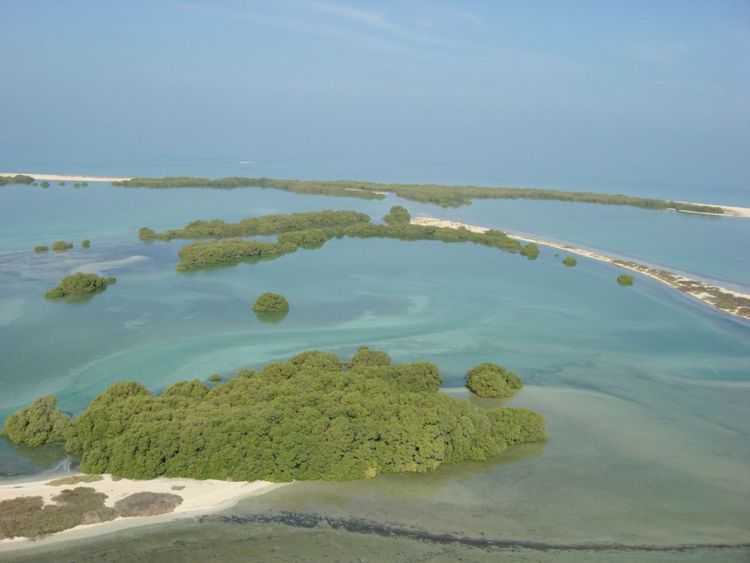 UAE - Planting mangroves using drones? That's what the Environment Agency - Abu Dhabi (EAD) aims to do as it unveiled the “Ghars Al Emarat” (UAE Planting Initiative), a programme initiated in conjunction with the Abu Dhabi Climate Change Strategy, Abu Dhabi Mangrove Initiative, and the UAE’s hosting of the 28th Conference of the Parties (COP28). During the upcoming final quarter of this year, mangroves will be strategically planted in the most optimal coastal habitats for their growth. These carefully chosen locations include the Marawah Marine Biosphere Reserve, Al Mirfa City, and Jubail Island, where natural mangrove ecosystems already thrive. This timeframe aligns with the ideal season for planting this species, ensuring the best conditions for their successful establishment. The “Ghars Al Emarat” initiative introduces a novel approach to mangrove planting, utilising innovative methods such as drone dispersal. For each attendee at the conference, approximately 10 mangrove trees will be planted, contributing to the preservation and expansion of this vital ecosystem. Under the patronage of Sheikh Hamdan bin Zayed Al Nahyan, Ruler’s Representative in Al Dhafra Region and Chairman of the EAD’s Board of Directors, this initiative aligns with the UAE Year of Sustainability in 2023. UAE - Planting mangroves using drones? That's what the Environment Agency - Abu Dhabi (EAD) aims to do as it unveiled the “Ghars Al Emarat” (UAE Planting Initiative), a programme initiated in conjunction with the Abu Dhabi Climate Change Strategy, Abu Dhabi Mangrove Initiative, and the UAE’s hosting of the 28th Conference of the Parties (COP28). During the upcoming final quarter of this year, mangroves will be strategically planted in the most optimal coastal habitats for their growth. These carefully chosen locations include the Marawah Marine Biosphere Reserve, Al Mirfa City, and Jubail Island, where natural mangrove ecosystems already thrive. This timeframe aligns with the ideal season for planting this species, ensuring the best conditions for their successful establishment. The “Ghars Al Emarat” initiative introduces a novel approach to mangrove planting, utilising innovative methods such as drone dispersal. For each attendee at the conference, approximately 10 mangrove trees will be planted, contributing to the preservation and expansion of this vital ecosystem. Under the patronage of Sheikh Hamdan bin Zayed Al Nahyan, Ruler’s Representative in Al Dhafra Region and Chairman of the EAD’s Board of Directors, this initiative aligns with the UAE Year of Sustainability in 2023.Shenzhen to be protection hub for mangroves
 CHINA - In a landmark victory for global mangrove preservation and cooperation, the Standing Committee of Ramsar Convention on Wetlands on Wednesday approved the establishment of the world's first international mangrove center in Shenzhen, Guangdong province. The National Forestry and Grassland Administration said the center in Shenzhen will help China to carry out international cooperation and exchanges on mangrove protection and restoration with all parties through the convention platform. "It will also promote global mangrove protection and restoration and rational utilization," the administration said. Considered "coast guards", mangroves can reduce erosion caused by storm surges, have important ecological functions of carbon sequestration and storage, and offer shelter to a variety of species, including fish, reptiles and amphibians. According to the Global Mangrove Alliance, mangrove forests cover about 14.7 million hectares worldwide — about the size of Bangladesh — and China's mangrove area has increased from 22,000 hectares in 2001 to 27,000 hectares today, making it one of the few countries in the world with an increase in mangrove areas. In Shenzhen, which boasts 35,000 hectares of wetlands, 296 hectares of them are dedicated to mangroves. Futian Mangrove Ecological Park, located in the heart of the city, is an important stopover site in the East Asian-Australasian Flyway for nearly 100,000 migratory birds every winter. CHINA - In a landmark victory for global mangrove preservation and cooperation, the Standing Committee of Ramsar Convention on Wetlands on Wednesday approved the establishment of the world's first international mangrove center in Shenzhen, Guangdong province. The National Forestry and Grassland Administration said the center in Shenzhen will help China to carry out international cooperation and exchanges on mangrove protection and restoration with all parties through the convention platform. "It will also promote global mangrove protection and restoration and rational utilization," the administration said. Considered "coast guards", mangroves can reduce erosion caused by storm surges, have important ecological functions of carbon sequestration and storage, and offer shelter to a variety of species, including fish, reptiles and amphibians. According to the Global Mangrove Alliance, mangrove forests cover about 14.7 million hectares worldwide — about the size of Bangladesh — and China's mangrove area has increased from 22,000 hectares in 2001 to 27,000 hectares today, making it one of the few countries in the world with an increase in mangrove areas. In Shenzhen, which boasts 35,000 hectares of wetlands, 296 hectares of them are dedicated to mangroves. Futian Mangrove Ecological Park, located in the heart of the city, is an important stopover site in the East Asian-Australasian Flyway for nearly 100,000 migratory birds every winter.Like this newsletter?  Pease consider donating to MAP to keep it going. Giving could never be easier *Articles in this newsletter may mention practices being used and/or show exagerated results being claimed without proof. Stories are presented here in effort to show mangrove related activity around the world and do not necessarily reflect Mangrove Action Project's views or mangrove restoration best-practices. ACTION ALERTSEcuador: Stop land grabbing and racial discrimination for palm oil! SIGN THE PETITIONUGANDA Stop criminalizing pipeline protesters! SIGN THE PETITIONSave Endangered Species From SpaceX
|
|
|
Mangrove Action Project Click here to view past newsletters
|
|
-
The community of adults and youth in Cayman Islands has come together recently to release a series of educational videos. Each is geared to...
-
By Alfredo Quarto, Program & Policy Director Co-founder, MAP There is a rather urgent situation concerning the bio-invasion of the Son...
-
By: Isabel Robinson, MAP Volunteer Intern Some months ago I decided to come to Thailand and do an internship in mangrove conservation, ...
MAP News Issue #596 = April 20, 2024
ENTRIES NOW OPEN! Mangrove Photography Awards 2024 10 Years Celebrating Mangroves GLOBAL - MAP has launched our 10th Mangrove Photograp...




